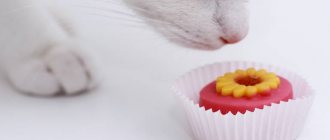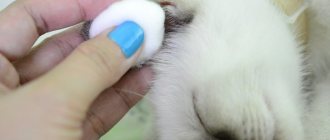Save the article:
Otitis is an inflammation of the ear, which can occur in cats in different forms and have different symptoms. Diagnostics allows you to establish the exact localization of the pathological process and the reasons that caused it. Depending on this, the veterinarian prescribes conservative treatment using appropriate medications. To prevent otitis media in cats, it is necessary to follow preventive measures, which include proper care of your pet.
Types and symptoms of otitis
global $ads_google; //data-ad-slot=”2475549904″ $ads_google = empty($ads_google) ? false : true; ?> if ($ads_google == false) {?>
$ads_google = true; ?> } ?>
The auditory organ consists of outer, middle and inner sections. Anatomical division formed the basis for the classification of otitis media. Types of the disease differ in the location of the source of inflammation. Otitis externa in cats occurs in the mildest form. The pathology does not affect the eardrum and functionally significant structures of the auditory analyzer. The auricle and external auditory canal suffer. If the process is not stopped in time, then it spreads to the deeper parts of the organ.
Symptoms of external otitis include redness of the ear, itching, and swelling of the tissues. During examination, the cat does not allow its ears to be touched, as touching causes pain. Most often, veterinarians diagnose parasitic, fungal or allergic otitis media in such cases.
Otitis media in cats is no less common. Inflammation affects the eardrum, internal auditory canal and tympanic cavity. The pet’s well-being is much worse compared to the first type. The disease sometimes occurs due to the spread of infection from the external part. It could be bacterial otitis media. Treatment in most cases gives a positive outcome, but advanced disease threatens to develop into purulent otitis media.
Bacterial otitis media of the middle ear may be accompanied by purulent-bloody discharge
When the inner ear becomes inflamed, the cochlea (auditory receptors, organ of balance) is affected. Inflammation develops, which can develop into the most severe purulent form. This type of disease is dangerous not only because of deafness, but also because of the possible spread of infection to brain structures. The disease is often accompanied by neurotic symptoms.
According to the speed of development and severity of the course, ear inflammation is divided into acute and chronic. A neglected process or incomplete treatment of an acute form provokes a chronic process. Common symptoms of otitis media in cats are:
- periodic scratching of the ear;
- constant shaking of the head;
- tilting the head to one side;
- unpleasant odor from the ears;
- release of exudate from the ear canal;
- redness of the ears;
- increase in body temperature;
- discharge of pus from the ears;
- neurotic attacks;
- loss of appetite.
Depending on the causes, otitis in a cat can be unilateral or bilateral.
Reviews
Experts and cat owners speak positively about the drug for various reasons. Owners note ease of use and accessibility. Veterinarians - product safety.
Konstantin, owner of Oriental, Moscow: “Orientals have huge ears and a genetic predisposition to ENT diseases. Although I examine him regularly, I missed the onset of inflammation. I only noticed when the cat began to shake his head and refuse to eat.
The clinic diagnosed otitis media. We recommended Otipax. At first it was very difficult to get him to lie still. But then the tailed one realized that I was trying to help. The symptoms disappeared on the 5th day of treatment. But on the doctor’s recommendation, I took the drops for another 2 days.”
Olga, cat owner, Ryazan: “What I liked was the accessibility. If necessary, the medicine can be bought at any pharmacy closest to your home.
The effect comes very quickly. Within 15 minutes the cat calmed down, stopped itching, and slept peacefully for the first time in several days. Everything went away within a week. I no longer find any discharge or brown crusts in my ears.”
Yulia Mikhailovna, veterinarian, St. Petersburg: “I do not advise self-medication, it is better to show your pet to a doctor. But if you need emergency help, Otipax is an affordable and effective medicine.
During my entire practice, side effects occurred only twice, and in both cases it was an allergy. The drug is completely safe even for kittens.”
Causes of the disease
Otitis media in cats can be caused by factors related to the functioning of the body, as well as environmental influences. These include:
- fleas and ticks. They are carriers of infection. Inflammation and irritation are also caused by waste products of parasites.
- foreign body. Once in the ear canal, small objects cause local inflammation and swelling.
- bacterial infection. Its development is facilitated by hypothermia, lack of vitamins, viral diseases, and weakened immunity.
- allergens. Individual intolerance to certain foods, medications, and detergents causes a release of histamine in the cat, which can result in allergic otitis media.
- parasitic fungi. They cause inflammation, which most often affects the outer and middle parts of the ear.
- neoplasms. Verrucous nevus and malignant tumors under certain conditions provoke an inflammatory process in the tissues of the auditory analyzer.
- injuries. In the absence of proper treatment, damaged skin turns into a fertile environment for infection. This is how bacterial otitis occurs. Inflammation of the internal part can occur due to injury to the temporal bone.
- autoimmune diseases. As a result of the rejection of one's own tissues, inflammation begins in the ear.
- hormonal disbalance. A change in the concentration of hormones (primarily produced by the adrenal glands, gonads, and thyroid gland) can provoke an inflammatory process.
- growth of fur in the ears. The high density of hairs stimulates the ceruminous glands, which produce earwax. This causes irritation and, as a result, scratching of the integument.
global $ads_google; //data-ad-slot=”2475549904″ $ads_google = empty($ads_google) ? false : true; ?> if ($ads_google == false) {?>
$ads_google = true; ?> } ?>
Diagnosis of otitis
When an animal exhibits symptoms of otitis media, it is necessary to contact a veterinary clinic. A doctor examines a diseased organ through an otoscope. This allows you to determine the location of inflammation. The condition of the eardrum is assessed, the presence or absence of foreign inclusions, neoplasms, and the amount of sulfur is determined.
As part of the diagnostic examination, a scraping of the cat's epithelium is taken. It is examined for the presence of subcutaneous mites. The doctor takes a smear of ear discharge for cytological analysis. The laboratory will determine whether bacteria and fungi are the cause of otitis media in your cat. For a general clinical picture, blood and urine are taken from the animal for study. If there is a suspicion of an allergy, then allergy tests are performed: small scratches are made on the skin and allergens are applied to them.
In a particularly difficult situation, when there is a suspicion of a tumor or damage to brain structures, the doctor may prescribe a referral for an X-ray or MRI. The deeper the source of inflammation is located, the more severe the disease. Based on the examination and test results, the veterinarian prescribes treatment for otitis with drops, tablets, and injections.
In some cases, an additional antibiogram is performed - a test for the sensitivity of microbes to certain antibiotics.
Veterinarian help
After the veterinarian has determined the causes of the cat's anxiety and made a diagnosis, he prescribes treatment. First of all, with the help of medications, the veterinarian relieves ear pain and itching in the cat. If there is discharge, dirt, or excess wax in the ears, then clean them. It is performed in the following sequence:
- The auricle is turned outward to provide access to the ear canal.
- The fur on the inside of the ear is carefully trimmed.
- A cotton swab is dipped in oil and the plaque is removed within sight.
- The second ear is treated in the same sequence.
For external otitis in a cat, the veterinarian treats the damaged surface and instills liquid medicine, after which he gently massages the auricle to evenly distribute the solution. In case of deep purulent otitis media, the cat's eardrum is pierced to remove pus from the distant parts of the ear. After deep cleaning, the ears are treated with systemic antibiotics. Owners of furry patients are advised to take note of the veterinarian's advice from the following video:
global $ads_google; //data-ad-slot=”2475549904″ $ads_google = empty($ads_google) ? false : true; ?> if ($ads_google == false) {?>
$ads_google = true; ?> } ?>
Treatment of otitis media in cats
Ear inflammation is a very serious disease, so self-treatment with drops or ointments at home without consulting a veterinarian is not recommended. If you suspect otitis in a cat, you should contact the clinic. After establishing the diagnosis, the doctor will prescribe detailed treatment based on the type of disease.
Purulent otitis media
The prescription of drugs for this type of inflammation depends on the nature of the pathogen. If bacteria are the culprit of the pathology, then otitis media is treated with antibiotics. When using such medications, you should be aware of your cat's sensitivity to them, as some medications cause side effects in animals. For cats, antibacterial agents of the class of cephalosporins, penicillin, and macrolides are used. The dosage is calculated individually for each four-legged patient, based on age, body weight, and severity of the disease.
If the eardrum is damaged, do not use ototoxic antibacterial drugs (Norfloxacin, Rifamycin, Ciprofloxacin), as they negatively affect hearing.
Fungal otitis media
For otomycosis, the cat is treated with fungicidal drops or ointments based on nystatin. Treatment of parasitic otitis necessarily includes hygiene procedures aimed at cleansing the surface of the outer ear. The ointments are applied to the clean surface for sanitation. In addition to local medications, the cat is prescribed general antifungal medications.
Treatment of otitis in cats should be carried out in compliance with general rules of care. The animal should be protected from drafts and hypothermia. It is necessary to minimize stressful situations. The pet should be at rest and warm.
Allergic otitis media
If the inflammatory process is associated only with increased histamine synthesis in the cat’s body, then antihistamines are used to relieve unpleasant symptoms. The animal is treated using Tavegil, Fexofenadine, Suprastin, Loratadine, Cetirizine. In case of severe inflammation, the use of anti-inflammatory corticosteroids (Prednisone, Prednisolone) is justified. In combination with them or separately, the doctor may prescribe Dexamethasone. Ear mites often cause an allergic reaction. In this case, antiparasitic treatment is necessary in parallel.
Parasitic otitis media
This common form of otitis in cats requires the use of special drugs, the action of which is aimed at destroying ear mites. Treatment is carried out using anti-inflammatory and acaricidal drugs. They can be in the form of ointments, aerosols, drops. Dekta, Amitrazine, Otopheronol Gold are suitable for this purpose. Therapy also includes regular cleansing of secretions from the auditory organ. Owners need to treat their pets for fleas and ticks on a schedule.
global $ads_google; //data-ad-slot=”2475549904″ $ads_google = empty($ads_google) ? false : true; ?> if ($ads_google == false) {?>
$ads_google = true; ?> } ?>
Side effects
An allergy to lidocaine has the most dangerous consequences for an animal. In this case, local irritation and itching appears. The cat shakes its head, constantly washes itself or scratches its ears. There is noticeable redness inside the ears, which accompanies swelling. Small rashes appear around the ears and inside the ear canals.
To check if your cat is allergic to the medicine, it is better to pre-drop half the recommended dose. Then, within 24 hours, evaluate the pet’s behavior.
If there is increased individual sensitivity to the components of the drug, use should be stopped immediately. To relieve allergic irritations, wipe the ears with infusion of chamomile, tea or boric alcohol.
Otipax has no systemic contraindications. Because it does not penetrate the blood and does not affect the general condition of the body.
Drops should not be used for any damage or deformation of the eardrum. In this case, the fluid penetrates the inner ear and irreversibly damages the animal's hearing system. If you are not sure whether the integrity of the eardrum is preserved, it is better not to experiment, but to show the cat to a specialist.
When used correctly at the recommended dosage, the medicine is safe. Allergic reactions to the components of the product are rare.
Medicines for otitis media
Treatment of otitis is carried out using systemic and local drugs. The prescription list includes medications recognized in veterinary medicine. Basic therapy can be supplemented with traditional medicine. To achieve a positive result, it is important to follow the treatment regimen and duration of the course prescribed by the veterinarian.
Medicines of official medicine
To sanitize the auricle and external auditory canal, use sterile gauze wipes soaked in an antiseptic solution. Boric acid (3%), chlorhexidine, hydrogen peroxide (3%), furatsilin, miramistin are suitable for this purpose. If the eardrum is not damaged, then drops for otitis media can be used for treatment:
- Sofradex;
- Dexamethasone;
- Aurikan;
- Uricin;
- Surolan;
- Anandin;
- Otibiovet;
- Tsiprovet;
- Tsipam;
- Otovedin.
Otibiovet
The medicine comes in the form of clear drops. The dropper bottle can have different volumes - 20, 30 or 50 ml. The drug is used for otitis of the external and middle ear. Active substances (gentamicin sulfate, triamcinolone acetonide, salicylic acid, carbetopendicinium bromide) act against bacteria and fungi. Drops reduce itching, discharge, and reduce the manifestations of dermatitis.
Surolan
An oily suspension containing miconazole nitrate, polymyxin B sulfate, prednisolone acetate. This is a combined drug that has anti-inflammatory, antibacterial, fungicidal, and antiallergic effects. The volume of the bottles is 15 or 30 ml.
If otitis in cats is caused by bacteria or they are a secondary cause of inflammation, systemic antibacterial drugs are prescribed. The use of these medications is also justified for fungal otitis in order to prevent infection by bacterial microflora. The list includes:
- Amoxiclav;
- Ampicillin;
- Amoxicillin;
- Cefazolin;
- Ceftriaxone;
- Cefixime;
- Erythromycin;
- Clarithromycin;
- Azithromycin;
- Spiramycin.
Ampicillin
global $ads_google; //data-ad-slot=”2475549904″ $ads_google = empty($ads_google) ? false : true; ?> if ($ads_google == false) {?>
$ads_google = true; ?> } ?>
Semi-synthetic drug of the penicillin series. Available in the form of tablets and powder for suspension. The medicine has a broad antimicrobial effect. The tablets are given to the cat on an empty stomach or 2 hours after eating.
Cefixime
Semi-synthetic antibiotic from the group of cephalosporins in tablets or powder. Active against many pathogenic bacteria. Used to treat otitis media in the acute stage. Not suitable for small kittens and sick elderly pets.
To treat integuments affected by parasitic fungi, fungicidal ointments are used: Panolog, Oridermil, Clotirmazol, Nystatin. In some cases, MycoStop ProVET antifungal drops are indicated. Complex therapy includes vitamin-mineral complexes and immunomodulators (Imunofan, Ribotan). They help the cat's body resist infection.
Folk remedies
Additional support for otitis media in cats is also provided by traditional medicine recipes. They are easy to prepare and use at home. The most harmless solution is considered to be a solution made from strong green tea. The filtered tea leaves are used to wipe the cat's ears. This product has a disinfectant and acaricidal effect. An infusion of herbs with antibacterial and anti-inflammatory effects has a similar effect. Chamomile, string, lavender, birch leaves, and St. John's wort are suitable for processing.
Composition and expiration date
Otipax is available in the form of alcohol-based drops in bottles of 16 g (15 ml). The package contains 1 bottle complete with a dropper.
The complex effect of the drug is manifested through the combination of 2 important components in its composition: phenazone and lidocaine.
Phenazone is a non-steroidal anti-inflammatory drug. It blocks cyclooxygenases, thereby slowing down and gradually eliminating the spread of infection.
Lidocaine is a powerful anesthetic. Prevents the passage of pain impulses in nerve fibers. Acting together, these components relieve pain within minutes (5-7 minutes) after use.
The medicine also contains excipients: sodium thiosulfate, alcohol and glycerol.
Otipax should be stored out of the reach of children and protected from direct sunlight at a temperature not exceeding +30 °C.
Prevention of ear otitis
To prevent the development of otitis media in a cat, you must follow simple rules of prevention. Periodically, your pet's ears are checked and excess wax and dirt are removed. For cleaning, you can use cotton pads or swabs, gauze wipes. In this case, only visible areas are treated with a cotton swab, without penetrating deep into the ear cavities.
The pet must be protected from drafts and hypothermia. This is especially important after swimming. When washing, water should not get into the animal's ears. After the water procedure, blot the inside of the ears with a cotton pad. Excess hair in the ears is trimmed, this improves ventilation of the ear cavity.
Kotofeya needs to be treated for fleas and ticks in a timely manner. Drops applied to the withers contain substances that kill subcutaneous mites, so they help prevent otodectosis. It is advisable to protect your pet from contact with homeless relatives, who are often carriers of infectious diseases.
At the first symptoms of otitis media, you should immediately seek help from a veterinarian, since advanced inflammation can develop into purulent otitis media.
It is more difficult to treat this form of the disease and, most importantly, it threatens serious complications. The cat may lose hearing, and in more severe cases, the infection can spread to the meninges and cause meningitis. global $ads_google; //data-ad-slot=”2475549904″ $ads_google = empty($ads_google) ? false : true; ?> if ($ads_google == false) {?> $ads_google = true; ?> } ?>
First signs
First of all, changes will affect behavior. If a cat's ear is infected, it will begin to rub it regularly and shake its head. At these moments the head tilts towards the diseased organ. Associated symptoms: poor appetite, lethargy and inactivity. Upon examination, redness, an unpleasant odor, and ulcers are detected. If treatment is not started, the disease will become chronic. In this case, the symptoms temporarily stop, and later the disease affects uninfected areas with renewed vigor.
We recommend the article: Why does a cat have dirty ears?
The pet's body temperature rises, vomiting, and behavior becomes distant. When you touch the ear, the cat may meow pitifully, because the pain intensifies every day. An advanced stage will cause convulsions and death of the animal.











